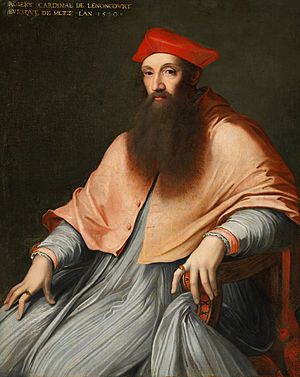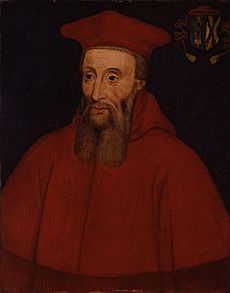Reginald Pole facts for kids
Quick facts for kids Reginald Pole |
|
|---|---|
| Cardinal Archbishop of Canterbury and Primate of All England |
|

Contemporary portrait by
Sebastiano del Piombo, 1549 |
|
| Church | Catholic Church |
| Enthroned | 22 March 1556 |
| Reign ended | 17 November 1558 |
| Predecessor | Thomas Cranmer |
| Successor | Matthew Parker |
| Orders | |
| Ordination | 20 March 1556 |
| Consecration | 22 March 1556 by Nicholas Heath |
| Created Cardinal | 22 December 1536 |
| Personal details | |
| Born | 12 March 1500 Stourton Castle, Staffordshire England |
| Died | 17 November 1558 (aged 58) London, Kingdom of England |
| Buried | The Corona, Canterbury Cathedral, Kent 51°16′48″N 1°04′57″E / 51.27995°N 1.08248°E |
| Parents | Sir Richard Pole Margaret Pole, Countess of Salisbury |
| Coat of arms | |
Reginald Pole (born March 12, 1500 – died November 17, 1558) was an important English cardinal of the Catholic Church. He was the last Catholic archbishop of Canterbury, serving from 1556 to 1558. This was during a time called the Counter-Reformation, when the Catholic Church was trying to respond to the rise of Protestantism.
Contents
Early Life and Education
Reginald Pole was born at Stourton Castle in Staffordshire, England, on March 12, 1500. He was the third son of Sir Richard Pole and Margaret Pole, 8th Countess of Salisbury. His family was very well-connected to the royal family. His great-uncles were kings Edward IV and Richard III.
Pole started his education at a young age. He went to Magdalen College, Oxford, in 1512, when he was only 12 years old. He had famous teachers there, like William Latimer. King Henry VIII even gave him money to help pay for his schooling. Pole earned his first degree in 1515.
After Oxford, Pole received several important church positions, even though he wasn't yet a priest. For example, he became the dean of Wimborne Minster and later the Dean of Exeter. In 1521, King Henry VIII sent him to the University of Padua in Italy. There, he met many leading thinkers of the Renaissance, a period of great cultural and intellectual growth.
Pole and King Henry VIII
Pole returned to England in 1526. King Henry VIII was trying to end his marriage to Catherine of Aragon. He wanted Pole to support his divorce. Henry even offered Pole important church jobs if he would agree.
However, Pole did not support the king's divorce. He believed it was wrong. In 1532, he decided to leave England and went to live in France and Italy. He continued his studies there.
In 1536, Pole made his disagreement with King Henry VIII very clear. He wrote a book called Pro ecclesiasticae unitatis defensione (which means "In Defense of the Unity of the Church"). In this book, he strongly criticized the king's actions, especially his divorce and his decision to become the head of the Church in England instead of the Pope. Pole even suggested that other European rulers should challenge Henry.
Because of Pole's strong opposition, King Henry VIII became very angry. He took revenge on Pole's family in England. Many of Pole's relatives, including his mother, Margaret Pole, Countess of Salisbury, were arrested and accused of treason. His mother was held in the Tower of London for two and a half years. She was eventually executed in 1541, even though she said she was innocent. Reginald Pole later said he was proud to be "the son of a martyr."
Becoming a Cardinal

On December 22, 1536, Reginald Pole was made a cardinal by Pope Paul III. A cardinal is a high-ranking official in the Catholic Church, just below the Pope. Pole was also made a papal legate to England, which meant he was the Pope's special representative.
The Pope wanted Pole to help support Catholic groups in England who were against King Henry VIII's changes. However, other European rulers did not want to get involved. The English government even tried to have Pole killed. In 1539, Pole tried to convince other countries to stop trading with England as a way to pressure Henry.
After Pope Paul III died in 1549, Pole was considered a strong candidate to become the next Pope. He received many votes at the meeting where the new Pope is chosen. However, he was not chosen. Some people accused him of having beliefs that were too close to Protestant ideas, which was a big problem for a Catholic leader.
Later Years and Archbishop of Canterbury
In 1553, King Edward VI died, and Mary I became Queen of England. Queen Mary was a strong Catholic and wanted to bring England back to the Catholic Church. This meant Reginald Pole could finally return home from exile.
In 1554, Cardinal Pole came back to England as the Pope's representative. He worked to help England rejoin the Catholic Church. He also helped Parliament pass laws that brought back older rules against heresy. Heresy meant having beliefs that went against the official teachings of the Church.
On March 20, 1556, Pole was finally ordained as a priest. Two days later, he became the archbishop of Canterbury, the most important church leader in England. He also became the head of both Oxford University and Cambridge University. Besides his religious duties, he was also a very important adviser to Queen Mary.
During Queen Mary's reign, many Protestants were executed for their beliefs. These events are known as the Marian Persecutions. About 220 men and 60 women were killed. While Pole was the Archbishop, his exact role in these persecutions is debated. Some evidence suggests he preferred a more gentle approach. These persecutions made many people in England turn against Catholicism.
Reginald Pole died in London on November 17, 1558, during a widespread illness. He died just hours after Queen Mary I passed away. He was buried at Canterbury Cathedral.
Writings
Pole was also a writer. He wrote books and many important letters about the authority of the Pope and the changes happening in the Church in England. These writings are very helpful for understanding the history of that time.
He was also known for strongly criticizing a famous book called The Prince by Machiavelli. Pole said that the book was written by "an enemy of the human race" because it seemed to suggest that rulers could use any means, even bad ones, to gain and keep power.
See also
 In Spanish: Reginald Pole para niños
In Spanish: Reginald Pole para niños
- Nicodemite


